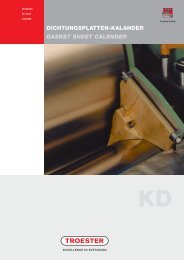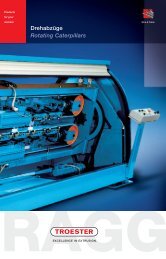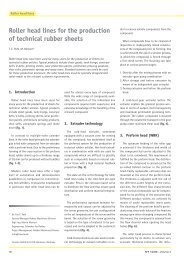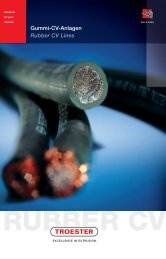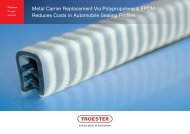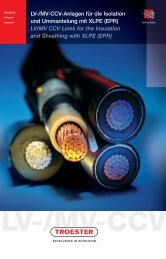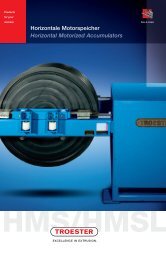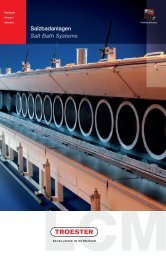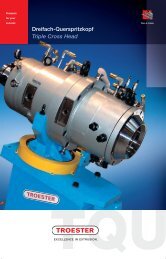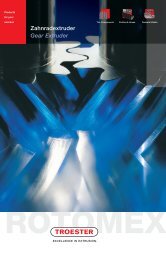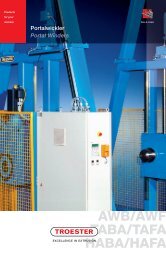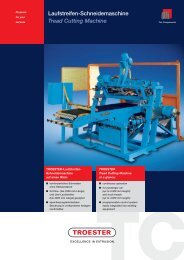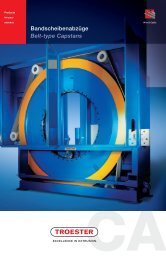Erfolgreiche ePaper selbst erstellen
Machen Sie aus Ihren PDF Publikationen ein blätterbares Flipbook mit unserer einzigartigen Google optimierten e-Paper Software.
Productsfor yoursuccess<strong>Roller</strong> <strong>Head</strong>/<strong>EWK</strong>-<strong>Systeme</strong><strong>Roller</strong> <strong>Head</strong>/Single-Roll <strong>Roller</strong> Die SystemsRH/<strong>EWK</strong>
Productsfor yoursuccessTECHNISCHE INFORMATIONTECHNICAL INFORMATIONDie <strong>Roller</strong> <strong>Head</strong>- und <strong>EWK</strong>-TechnologieTROESTER-Maschinen und -Anlagen zur Kautschukverarbeitung sind seitüber 100 Jahren ein Synonym für Zuverlässigkeit und Effektivität. So helfenauch die <strong>Roller</strong> <strong>Head</strong>- und Einwalzenkopf-Technologie – einzeln oder auchim Rahmen einer kompletten Anlage kombiniert – bei der wirtschaftlichenHerstellung hochwertiger profilierter und unprofilierter Kautschukprodukte.Das <strong>Roller</strong> <strong>Head</strong>-System setzt dort an,wo Kalandern produktionstechnischeGrenzen gesetzt sind. In den <strong>Roller</strong> <strong>Head</strong>-Kopf eingespeist, erreicht die plastifizierteKautschukmischung sofort dievolle Produktionsbreite. Das RH-Verfahrenverhindert Lufteinschlüsse undgestattet ausgewalzte Bahnen bis zuca. 20 mm Dicke in engen Toleranzen. Im Vergleich dazu erreicht eineklassische Kalanderanlage im einfachen Durchlauf max. 3 mm; darüber hinausmuss mit Lufteinschlüssen gerechnet werden. Der Einsatz von <strong>Roller</strong> <strong>Head</strong>-<strong>Systeme</strong>n eignet sich für unprofilierte Produkte wie z. B. glatte Platten undBahnen sowie für profilierte Kautschukprodukte durch den Einsatz einerWalze mit austauschbarer Profilhülse.Der Einwalzenkopf (<strong>EWK</strong>) ist konzeptionell anders gestaltet als der Walzenbreitspritzkopf(WBK). Beim <strong>EWK</strong> ist die Walze fester Bestandteil des Kopfes.Die sehr einfachen Werkzeuge können innerhalb weniger Minuten ohne Öffnendes Kopfes gewechselt werden. Durch die <strong>EWK</strong>-Technologie kann die Produktionvieler Arten von Kautschukbahnen und -profilen, auch mit Höhen über30 mm, realisiert werden; denn ein <strong>EWK</strong>-Aggregat kombiniert die Vorteileder direkten Extrusion mit denen desqualitätssteigernden Kalandrierensund bietet darüber hinaus zusätzlicheProduktionsmöglichkeiten füreine Vielzahl von profilierten Bahnenoder Platten, die im Extrusionsverfahrenoder mit der bekanntenKalandriertechnik nur unwirtschaftlichbzw. nicht herstellbar sind.Welcher Aggregat-Typ für Ihre Anforderungenauch der richtige ist, beiProduktionslösungen von TROESTERdürfen Sie sicher sein, daß Sie einSystem einsetzen, das dem letztenStand der Technik entspricht undIhre Fertigung produktiver macht.<strong>EWK</strong>-<strong>Systeme</strong>Das Einwalzenkopfsystem (<strong>EWK</strong>)besteht in der Regel aus einem kaltgefüttertenQSM-Extruder und demEinwalzenkopf. Dieses System istdamit die optimale Kombination auseinfacher Handhabung des direktenExtrusionsverfahrens und den qualitätssteigerndenMerkmalen desKalandrierverfahrens. Mit dem <strong>EWK</strong>lassen sich profilierte Kautschukbahnenvon hoher Qualität in unterschiedlicherBreite und Dickeherstellen, wie z. B. Seitenwandstreifenfür Autoreifen, Felgenhorn-Streifen, Profilstreifen (auch mitseitlicher Kehlung und hochempfindlichen,dünnwandigen Teilbereichen),Laufstreifen, Apex-Streifen,Innerliner, Kautschukbahnen fürTransportbänder u.a.m..Die im Extruder plastifizierte Kautschukmischungwird durch den amExtruder angeflanschten Einwalzenkopfendgültig ausgeformt. Er bestehtim wesentlichen aus drei Teilen,die gemeinsam den Ausformspaltbilden: dem temperierten Kopf miteingearbeiteten Fließkonturen zurVorverteilung des Materials, derebenfalls temperierten Walze undeiner auswechselbaren Spritzleisteam schwenkbaren Kopfoberteil.Die Kautschukmischung wird unterniedrigem Druck, d. h. ohne zusätzlicheTemperaturbelastung, in denformgebenden Spalt gegeben.Infolge der Walzendrehung entstehtim Kopfbereich und im Ausformspalteine Schleppwirkung, die durch dieMischungshaftung auf der temperiertenWalzenoberfläche bewirktwird. Durch das richtige Abstimmender Walzentemperatur und derUmfangsgeschwindgkeit der Walzemit dem Extruderausstoß und derAbzugsgeschwindigkeit lassen sichproblemlos auch kompliziertesteProfile mit großem
<strong>EWK</strong>Das Einwalzenkopf (<strong>EWK</strong>)-System auf einen Blick:■ hohe Produktionsleistung■ hervorrragende Produktgenauigkeit■ niedrigste Spritzwerkzeugkosten■ kurze Umrüstzeiten durch einfachenWerkzeugwechsel■ für Kehlprofile geeignet■ Materialschwellung nach Ausformungdurch Walzengeschwindigkeit undAbstand Walze/Leiste beeinflußbar■ problemloser Materialfluss bei Profilenmit großen Dickenunterschieden (beigradlinigem Verlauf)■ größere Materialdichte durch reduzierteoder vermiedene PorositätDickenunterschied, seitlicherKehlung und lang auslaufenderSpitze ausformen. Besondershervorzuheben ist dabei die hoheProduktgenauigkeit bei geringerMaterialquellung, was die Herstellungund Anpassung der Profilleistenvereinfacht. Das Profil entsprichtnämlich nahezu der Geometrie derSpritzleiste, wodurch aufwendigeund zeitraubende Nacharbeitenstark reduziert werden.Bedingt durch eine niedrigereMassetemperatur sind mit einem<strong>EWK</strong> (im Vergleich mit anderenExtrusionsanlagen) höhere Produktionsgeschwindigkeitenmöglich.Gegenüber Kalanderanlagen ist einannähernd gleiches Fertigungstempozu erreichen, sofern entsprechendeMischungsmengen angebotenwerden. Die Bedienung des <strong>EWK</strong>-Systems ist denkbar einfach:Die Verklammerung des schwenkbarenKopfoberteiles mit dem feststehendenUnterteil übernehmenzwei seitlichangeordneteHydraulikzylinder.Ein Keilkammarretiert bzw. löstdie Spritzleistehydraulisch. Das gewährleistet beieinem Produktionswechsel ein leichtesund schnelles Auswechseln derformgebenden Fertigspritzleiste. Umdie Dicke des Profils zu optimieren,ist die Walze in der Höhe über motorischangetriebene Spindeln verfahrbar,wodurch sich der Abstand zwischenSpritzleiste und Walze exakteinstellen läßt.Messtechnische Zusatzausrüstungenunterstützen das schon vom Prinzip■ geringe Massetemperaturen durchgeringe Ausformdrücke■ Haftfähigkeit der produzierten Bahnbleibt für nachfolgende Belegungmit anderen Bahnen erhalten■ geringerer Investitionsaufwandgegenüber Kalandrierverfahrenher leicht beherrschbare Handlingeiner <strong>EWK</strong>-Produktionseinheit.So können Schnecken- und Walzendrehzahlin Abhängigkeit vomMassedruck des Kopfes aufeinanderabgestimmt werden, und Massedruck,Temperatur, Walzendrehzahlund der Spalt sogar digital geprüftund das Produkt berührend bzw.berührungslos gemessen werden.Der Einsatz der messtechnischenMöglichkeiten orientiert sich dabeiam individuellen Bedarfsfall.
Einwalzenkopf (<strong>EWK</strong>) mit ExtruderSingle Roll <strong>Roller</strong> Die with extruderTechnische Daten der bisher ausgeführten<strong>EWK</strong>-Größen (ausgewählte Beispiele)Technical Data of the Single-Roll <strong>Roller</strong> Diesizes performed up to now (selected examples)Einwalzenkopf eines<strong>EWK</strong>-Systems(Oberteil geöffnet undgeschlossen)<strong>Head</strong> of a Single-Roll<strong>Roller</strong> Die System(with upper partopened and closed)Schemadarstellung einer Innerliner-AnlSchematic overview of a innerliner line
The Single-Roll <strong>Roller</strong> DieSystem at a Glance:■ high production capacity■ excellent product precision■ Very low tooling costs■ short change-over times due toeasy tooling changes■ suitable for undercut profiles■ material swelling after shaping canbe controlled by roll speed androll/die distance■ smooth material flow for profileswith great thickness variations(with straight product path)■ high material density due to reducedor avoided porosity■ low compound temperatures dueto low die pressure■ produced sheets remain adhesivefor later coating with other sheets■ low investment cost as comparedto calender systems<strong>EWK</strong>ge (mit 2 x <strong>Roller</strong> <strong>Head</strong> und <strong>EWK</strong>)(with 2 <strong>Roller</strong> head and <strong>EWK</strong>)Single-Roll <strong>Roller</strong> DieSystemsThe Single-Roll <strong>Roller</strong> Die systemgenerally consists of a cold-feedpin-type extruder and a Single-Roll<strong>Roller</strong> Die. Thus it is the optimalcombination of the easy operationof direct extrusion and the qualityimprovingcharacteristics of thecalendering process. The Single-Roll <strong>Roller</strong> Die can be used toproduce high-quality profiled rubbersheets in different widths andthicknesses, such as, for example,sidewalls for automobile tires, rimstrips, profile strips (also withundercut and highly sensitive, thinwall sections), treads, apex strips,innerliners and rubber sheets forconveyor belts among many otherthings.The rubber compound plasticized inthe extruder is given its final shapeby the head of the Single-Roll <strong>Roller</strong>Die, which is flanged onto theextruder. It essentially consists ofthree parts, which together formthe shaping gap: the temperaturecontrolledhead with flow channelsincorporated into it for pre-distributionof the material, the temperature-controlledroll and anexchangeable plate die on thehinged upper part of the head.The rubber compound is fed intothe shaping gap under low pressure,i. e., without excessivelyincreasing the temperature.As the roll turns,a dragging effect occurs in thehead area and in the shapinggap, which is caused by thecompound adhering to the temperature-controlledroll surface. Byad-justing the roll temperature andthe overall speed of the roll to theextruder output and the take-offspeed, even the most complex profileswith great thickness variations,undercut and long, angled tips canbe easily shaped. An importantfeature is the high product precisionwith low material swelling, whichsimplifies the production and adjustmentsof the profile strips. Thegeometry of the profile correspondsvery closely to that of the plate die,which greatly reduces expensiveand time-consuming rework.The Single-Roll <strong>Roller</strong> Die makeshigher production speeds possibledue to lower compound temperatures(in comparison with otherextrusion systems). Nearly the sameproduction speed can be achievedas with calender lines, as long ascorresponding compound quantitiesare offered. The Single-Roll <strong>Roller</strong>Die system is extremely easy tooperate: clamping the hinged headupper part to the fixed lower partusing two hydraulic cylinders on thesides. A wedge comb hydraulicallyfixes or releases the plate die. Thismakes the shaping final plate dieeasy and fast to exchange forproduction changes. In order tooptimize the thickness of the profile,the roll can be moved using motordrivenspindles, which allows thedistance between the plate die androll to be precisely adjusted.Additional measurement technologysupports the already easy operationof a Single-Roll <strong>Roller</strong> Die productionunit. Screw and roll speed canthus be adjusted to one anotherdepending on the compound pressurein the head, and compoundpressure, temperature, roll speedand the gap size can be digitallymeasured. The product can alsobe measured tactilely or contactfree.Which of the different optionsin measurement technology areused can be determined byindividual requirements.
TECHNISCHE INFORMATIONTECHNICAL INFORMATION<strong>Roller</strong> <strong>Head</strong>-<strong>Systeme</strong>Unter einem <strong>Roller</strong> <strong>Head</strong>-Aggregatversteht man die Kombination einesExtruders mit Breitspritzkopf undeinem Zwei-Walzen-Kalander (kannauch ein 3- oder 4-Walzen-Kalandersein). Die <strong>Roller</strong> <strong>Head</strong>-Technikbietet zwei entscheidende Vorteile:Zum einen die hohe Gleichmäßigkeitder Materialdicke über die volleBahnbreite, die auch bei größerenDicken Luftblasenfreiheit gewährleistet;zum anderen die hervorragendeHomogenität des ausgewalztenMaterials. Beide Produktionsmerkmalesind optimaleVoraussetzungen für hochwertigeKautschukprodukte,wie Reifenbauteile, Keilriemenbahnen,Transportbänder,Behälter-Auskleidungen,Deckplatten, Rohlingsplatten,Dachfolien, u.a.m..Diese große Fertigungsvielfaltist möglich, weil beim <strong>Roller</strong><strong>Head</strong>-Aggregat (im Vergleichzur klassischen Kalanderanlage,auf der zur Vermeidungvon Lufteinschlüssennur Bahnen bis zu 3 mm Dicke ineinfachem Durchlauf hergestelltwerden) Bahnendicken bis zuca. 20 mm erreicht werden.Die Kautschukmischung wird imExtruder plastifiziert und dann inden <strong>Roller</strong> <strong>Head</strong>-Kopf eingespeist.Hier gelangt die Mischung über diegesamte Arbeitsbreite des Kalandersverteilt direkt in den Walzenspalt.Diese direkte Zuführung vermeidetden sonst üblichen Rollwulstund die Lufteinschlüsse, so dassdie im <strong>Roller</strong> <strong>Head</strong>-Kopf vorgeformtePlatte eine Dicke von 10 mm bis30 mm aufweisen kann, die derKalander dann auf die gewünschteEnddicke kalibriert. Sind demKalander Dickenmesseinrichtungennachgeschaltet, können derenMesswerte zur Ansteuerung derWalzenverstellung genutzt werden.Das gewährleistet automatisch diekontinuierliche Dickenregelung fürdas kalandrierte Produkt.Um die elastische Durchbiegungder Walzen unter Last auszugleichen,die zu einem in der Bahnenmittedickeren Produkt führenwürde, sind drei Kompensationsmöglichkeitenoder deren Kombinationanwendbar: Bombage, Schrägverstellungoder Gegenbiegung derWalzen. Das Ergebnis ist ein überdie gesamte Breite dickengleichesProdukt.Der Breitspritzkopf besteht aus zweiTeilen, die im materialführendenBereich spezielle hartverchromteFließkonturen aufweisen. Sie verteilendas Material gleichmäßig überdie gesamte Arbeitsbreite. In beidenKopfteilen befinden sich auswechselbareSpritzleisten, die am Austrittzum Walzenspalt für die genaueAnpassung der Spritzkopföffnungan die vorgesehene Bahnendickesorgen. Mit Einlegteilen kann dieSpritzbreite so eingeschränktwerden, dass bei kleineren Arbeitsbreitenübergroße Randbeschnittevermieden werden.Die Temperierung der Spritzkopfgehäuseteileerfolgt über Heiz-/Kühlkammernmit Temperaturfühlern, dieder Walzen erfolgt über längs zurBallenoberfläche angeordneteDie <strong>Roller</strong> <strong>Head</strong>-Anlageauf einen Blick:■ hohe Produktionsleistung■ sehr dicke Bahnen beigroßen Breiten herstellbar■ hervorrragende Produktgenauigkeit■ schneller Profilwechseldurch Austausch derWalzenhülse innerhalbvon ca. 5 Minuten■ Materialschwellung durchKalibriervorgang im WalzenspaltbeeinflußbarPeripherbohrungen.Die in mehrereGruppen aufgeteiltenBohrungen werdenvom Temperiermediummäanderförmigdurchströmt – dasgewährleistet einehochgenaue Temperaturführungsowieschnelles Aufheizenund Ansprechen aufTemperaturänderungenüber diegesamte Walzenbreite.Der Extruder ist auf einer hydraulischverfahrbaren Grundplatte montiert.Dies ermöglicht das Zurückfahrendes Extruders inkl. Spritzkopf vomfeststehenden Kalander, z. B. für dieSpritzkopfreinigung bei Produktionsendeoder zum Austausch der Spritzleistenund Einlegteile bei Dimensionswechsel.
The <strong>Roller</strong> <strong>Head</strong> and Single-Roll <strong>Roller</strong> Die TechnologyFor over 100 years, TROESTER machines and lines for rubber processinghave been synonymous with reliability and efficiency. Our <strong>Roller</strong> <strong>Head</strong> andSingle-Roll <strong>Roller</strong> Die technology also aid in the economical production ofhigh-quality profiled and unprofiled rubber products, either individually oras part of a complete line.The <strong>Roller</strong> <strong>Head</strong> system is used where calenders reach their productionlimits. When the plasticized rubber compound is fed into the preform head,Für die Produktion profilierterStreifen oder Bahnen kann derKalander mit einer Profilwalzeversehen werden. Diese bestehtaus einem temperierten Walzenkernund einer aufgeschobenen profiliertenHülse. Mit einer hydraulischbetätigten Wechseleinrichtungläßt sich die Hülse innerhalb vonca. 5 Minuten austauschen.Das <strong>Roller</strong> <strong>Head</strong>-Aggregat ist zurKonstanthaltung des Massedruckesstandardmäßig mit einer Massedruck-/Drehzahl-Regelungausgerüstet.Bei unzulässigen Druckabweichungeninnerhalb derSicherheitsparameter wird dieDrehzahl des Extruders bzw. desKalanders korrigiert. Beim Erreichendes Maximalducks oder bei fehlenderVerbindung zwischen Massedruckgeberund Messverstärkerwird der Extruder automatisch abgeschaltet.Die <strong>Roller</strong> <strong>Head</strong>-Anlagebietet darüber hinaus weitereSicherheitsvorrichtungen, die denneuesten Unfallverhütungsvorschriftenentsprechen. Über demWalzenspalt verläuft in der Breiteder Walzen eine Not-Aus-Reißleine,deren Betätigung den unmittelbarenStillstand des Kalanders bewirkt.Automatisch öffnen die Verstellmotorenden Kalanderspalt undein akustisches Signal meldet dieNotabschaltung. Über Tippbetriebkann der Kalander daraufhin inKriechgang geschaltet werden.it immediately reaches its full production width. The <strong>Roller</strong> <strong>Head</strong> processprevents air inclusions and permits sheets of up to approx. 20 mm thick to berolled out in precise tolerances. By comparison, a classic calender line canonly achieve a maximum of 3 mm with a single path, and the possibility of airinclusions must also be accounted for. <strong>Roller</strong> <strong>Head</strong> systems are suitable forunprofiled products like smooth sheets. Profiled rubber products can beproduced using a roll with exchangeable profile sleeve.The Single-Roll <strong>Roller</strong> Die has a different conception from that of a preformhead. In the Single-Roll <strong>Roller</strong> Die the roll is a fixed part of the head. The verysimple tools can be exchanged within a few minutes without opening thehead. Many types of rubber sheets and profiles can be produced with Single-Roll <strong>Roller</strong> Die technology, even with heights over 30 mm. This is because aSingle-Roll <strong>Roller</strong> Die unit combines the advantages of direct extrusion withmost of the quality-improving advantages of calendering, and thus offersadditional production options for a large number of profiled sheets that areexpensive or impossible to produce with the current calender technology.No matter which type of unit is right for your requirements, with TROESTERyou can be certain that you are using a state-of-the-art system which makesyour manufacturing more productive.Mini <strong>Roller</strong><strong>Head</strong> fürSpezial-AnwendungenMini <strong>Roller</strong><strong>Head</strong> forspecialdemands<strong>Roller</strong> <strong>Head</strong>-Anlage zur Produktionvon Kautschukbahnen<strong>Roller</strong> <strong>Head</strong> Line for the productionof rubber plates
Mini <strong>Roller</strong> <strong>Head</strong>-System KDi 80 x 150 WBK 90/120 für die Herstellungschmaler hochgenauer planparalleler oder profilierter Streifen.Mini <strong>Roller</strong> <strong>Head</strong> System KDi 80 x 150 WBK 90/120 for the production ofsmall plane-parallel or profiled stripes with highest accuracy.RHAbmessungenfür Bahn-/Arbeitsbreiten in StandardgrößenFinal sheet widths and standard roll dimensionsWichtige Bestandteileeiner Anlage zur Herstellungvon Kautschukbahnen(v. l. n. r.):Extruder mit Breitspritzkopf,Kalander, Doublierstationund KühlstuhlKey Units of a line for theproduction of rubberplates (from left to right):extruder with preformhead, calender, laminatingstation and cooling station
<strong>Roller</strong> <strong>Head</strong>-SystemKDi 300 x 850 WBK 150/700<strong>Roller</strong> <strong>Head</strong> SystemKDi 300 x 850 WBK 150/700<strong>Roller</strong> <strong>Head</strong> SystemsA <strong>Roller</strong> <strong>Head</strong> unit is a combinationof an extruder with a preform headand a two-roll calender (can also bea 3- or 4-roll calender). <strong>Roller</strong> <strong>Head</strong>technology offers two decisive advantages:one is the high uniformityof the material thickness over theentire sheet width, which ensuresthat there will be no air inclusions,even at higher thicknesses.Another is the outstanding homogenityof the material produced.Both production characteristics areoptimal pre-requisites for highqualityrubber products such astire components, V-belts, conveyorbelts, tank linings, cover sheets,blank sheets and roofing sheets,among many other things.This great product variety ispossible because the <strong>Roller</strong> <strong>Head</strong>unit (in comparison to the classiccalender line, which can onlyproduce sheets of up to 3 mm thickwith a single path in order toprevent air inclusions) can producesheets of up to approx. 20 mmthick.The rubber compound is plasticizedin the extruder and then fed into thepreform head. It enters the calenderdirectly in the roll gap, and is distributedover the entire working widthof the calender. This direct feedingprevents the build-up in front ofthe nip, that would otherwise beexpected as well as air inclusions,so that the sheet pre-formed in thepreform head can have a thicknessof 10 mm to 30 mm, which thecalender then calibrates to thedesired end thickness. If thicknessmeasuringequipment is downstreamfrom the calender, itsmeasured value can be used tocontrol the roll adjustment. Thisautomatically guarantees continuousthickness regulation for thecalendered product.In order to compensate for theelastic deflection of the rolls, whichwould lead to a thicker product inthe middle of the sheet, there arethree options that can be usedalone or in combination with oneanother: roll crowning, roll crossingor roll bending. The result is aproduct with an even thicknessacross its entire width.The preform head consists of twoparts with special hard-chromeplated flow channels in the materialfeeding area. They distribute thematerial evenly over the entireworking width. Both head partshave exchangeable plate dies,which make sure that the headopening is adjusted precisely for thedesired sheet thickness. Inserts canbe used to decrease the extrusionwidth to avoid excessive edgetrimming with smaller workingwidths.The temperature of the headhousing parts is controlled withheating/cooling chambers withtemperature sensors. The rolltemperature is controlled by meansof peripheral bores along the rollsurface. The bores are distributedin several groups and channel thetemperature-control medium inmeandering form – this makes forhighly precise temperature controlas well as fast heating and reactionto temperature changes over theentire roll width.The extruder is mounted on ahydraulically moveable baseplate.This makes it possible to move theextruder, including the head, awayfrom the fixed calender, for examplefor head cleaning at the end ofproduction or to exchange the platedies and insert parts when changingsizes.<strong>Roller</strong> <strong>Head</strong> Systemsat a Glance:■ high production capacity■ very thick sheets can beproduced in wide widths■ excellent product precision■ profiles can be changedwithin 5 minutes bychanging the roll sleeve■ material swelling canbe influenced by calibratingwithin the roll gapThe calender can have a profile rollfor production of profiled strips orsheets. This consists of a temperature-controlledroll core and aprofiled sleeve that slides onto it.The sleeve can be changed within5 minutes with a hydraulicchanging device.Standard equipment for the <strong>Roller</strong><strong>Head</strong> unit includes a compoundpressure/ speed regulator. If thepressure falls out of the allowablerange but within safety parameters,the speed of the extruder and/orthe calender is corrected. When themaximum pressure is reached, or ifthere is no connection between thecompound pressure indicator andmeasuring amplifier, the extruderis automatically shut off.In addition, the <strong>Roller</strong> <strong>Head</strong> unithas many safety devices thatcorrespond to the latest accidentpreventionregulations. An emergencystop cable runs along thewidth of the roll, which causes thecalender to shut down immediately.The adjusting motors automaticallyopen the calender gap and anauditory signal sounds to report theshut-down. The calendercan then be set to runat slow speed injog mode.
TROESTER:A TRADITION OF INNOVATIONFür etwaige Garantien oder Gewährleistungsverpflichtungen ist ausschließlich der Vertrag zwischen Kunden und TROESTER maßgebend. Die hier gemachten Angaben stellen keinerlei Zusicherungenirgendwelcher besonderer Eigenschaften dar, sie dienen lediglich der allgemeinen Information und können im Einzelfall abweichen. Ansprüche irgendwelcher Art können hieraus nicht abgeleitet werden.Die Beachtung gewerblicher Schutzrechte ist in jedem Fall Sache des Kunden. Only the contract between the customer and TROESTER is binding for any guarantees and commitments. The particularsgiven herein do not represent promises of any special characteristics. They serve purely for general information purposes and may differ in individual cases. No claims of any nature may be derivedherefrom. The observation of commercial trade marks or patents shall in every instance be the responsibility of the customer.RH/<strong>EWK</strong> · 2006/03 · 500 · D/ERother, van Cleef. Design & KommunikationMachines and complete lines built byTROESTER are known all over the worldand are synonymous with technologicaladvancement, quality and outstandingperformance in the fields of rubber andcable processing.CONTACTSTROESTER GmbH & Co. KGP.O. Box 89 01 8030514 Hannover, GERMANYPhone +49-511-8704-0Fax +49-511-864028E-mail info@troester.dewww.troester.dewww.troester.deTROESTER Machinery, Ltd.300 Loomis AvenueCuyahoga Falls, Ohio 44221, USAPhone +1-330-928-7790Fax +1-330-928-7239E-mail info@troester-usa.comwww.troester-usa.comTROESTER Machinery (Shanghai) Co., Ltd.Workshop No. 9No. 6999 Chuan’sha RoadPudong New AreaShanghai 201202, PR CHINAPhone +86-21-58598308Fax +86-21-58598310E-mail info@troester.cnTROESTER Moscow50, Zemlyanoy Val, Room No. 1102 GIAPMoscow, 109815, RUSSIAPhone & Fax +7-495-9166093E-mail lusia137@rol.ru



